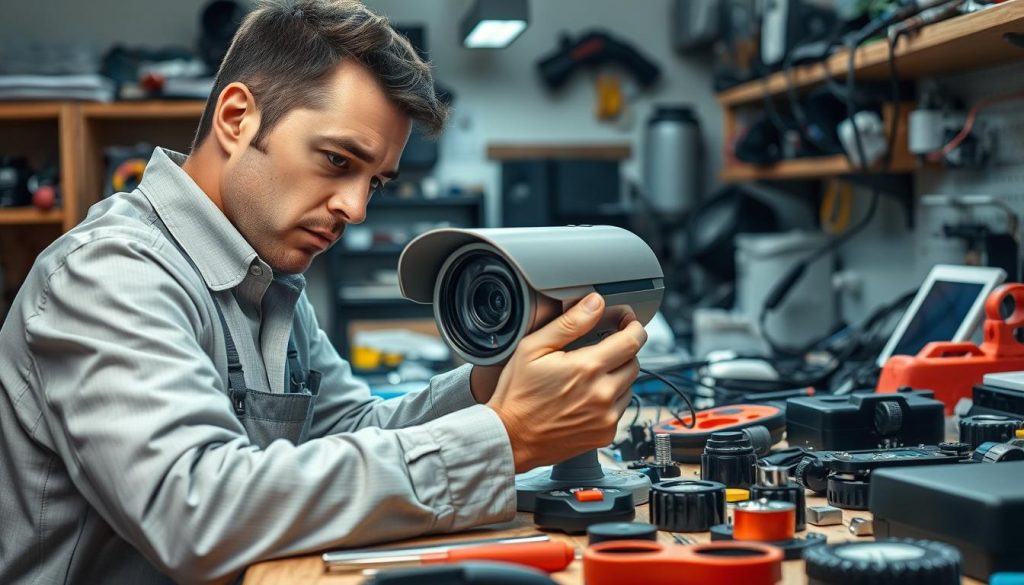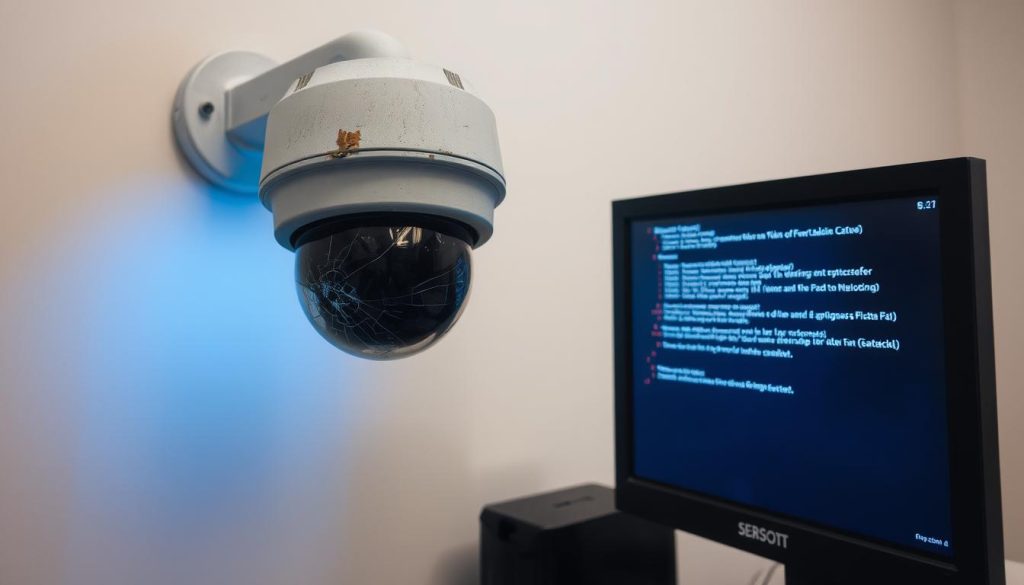CCTV cameras are key to security in homes and businesses in Singapore. But, they can suddenly stop working, causing big security risks. This problem, known as CCTV video loss, can leave places open to threats.
Knowing why these issues happen is important. Problems like power issues, network problems, and software bugs can cause them. Spotting these quickly helps fix the issue fast and keeps security strong.
Key Takeaways
- Common reasons for CCTV malfunction include power supply problems and connectivity issues.
- Assessing the health of the power supply can prevent CCTV video loss.
- Regularly updating firmware is vital for maintaining camera functionality.
- Conducting physical inspections of cameras can help identify wear and tear.
- Understanding camera settings is key for solving problems.
- Seeking professional help may be needed for ongoing issues.
Common Reasons for CCTV Camera Malfunction
CCTV cameras can stop working for many reasons. One big cause is a power problem. This can happen if cables are loose or damaged.
Another issue is network problems. These can block video from showing up. Users might see a black screen or no video at all.
Old firmware is another problem. It might not work with new updates. Knowing these issues helps users fix problems fast. This can save time and avoid needing a professional.
Power Supply Issues
CCTV power supply problems often cause surveillance systems to malfunction. If the power supply is not enough or is unstable, cameras might stop working or lose video feed at times. To fix these issues, start by checking the power connections, which can get loose over time.
Worn-out cables or faulty power supplies can also cause problems. Regular maintenance is key to avoid these issues. Check all connections and replace any worn-out parts to prevent sudden failures.
Adding Uninterruptible Power Supplies (UPS) to your system can also help. UPS systems provide backup power during outages. This ensures your surveillance system keeps working even when the main power goes out.
Why CCTV Camera Suddenly Stopped Working?
Figuring out why a CCTV camera stopped working involves looking at a few key areas. Users must do a detailed check to find out what went wrong. This helps fix problems in video surveillance systems.
Checking Power Connections
Physical connections are very important for camera work. Cables can get loose or damaged over time. This can cut off power to the CCTV system.
For wired setups, checking power cables and connectors is key. A simple fix like reconnection or replacement can solve power issues.
Assessing Battery Health in Wireless Cameras
For wireless cameras, battery health is a big deal. Users should check batteries often to make sure they’re charged and working right. A weak battery can cause video loss, making Wi-Fi signals weak too.
Regular checks can really help keep surveillance systems running smoothly.
Network Connectivity Problems
Network connectivity is key for CCTV systems, like those with IP cameras. Fixing CCTV network issues quickly makes your surveillance system more reliable. It’s important to check both wired and wireless connections for smooth performance.
Testing Wired and Wireless Connections
Doing CCTV connectivity tests is vital to check your network’s health. For wired connections, make sure cables are tight and not damaged. Loose cables can cause video quality issues.
For wireless connections, check if the camera is close enough to the Wi-Fi. Weak signals can affect how well it works.
Pinging the Camera’s IP Address
Pinging the camera’s IP address helps find network problems. A ping test shows if the camera is connected. If it fails, look for issues like IP address conflicts or router settings problems.
Cable and Wiring Issues
CCTV wiring problems often cause camera malfunctions. Issues like cable damage and wrong installation can hurt video quality or stop service. Regular checks are key to spotting problems early.
When checking cables, look for signs of wear, fraying, or corrosion. This helps catch issues before they get worse.
It’s vital to install cables right during troubleshooting. Too many bends or twists can damage cables over time. Using high-quality cables and avoiding bad extensions helps keep your system running well.
By taking these steps, you can avoid future problems. This ensures your surveillance gear works as it should.
Firmware and Software Updates
Keeping CCTV systems up to date is key for top performance and security. Regular updates stop software issues in CCTV that could harm video quality and connection. Manufacturers often release updates to fix bugs and improve security.
Importance of Firmware Upgrades
Old firmware can cause problems like video loss and system failures. It’s important to check for updates often. This ensures your cameras work well and stay safe.
For systems with many cameras, follow the maker’s update plan. This helps avoid big problems during updates.
Physical Inspection of Components
A thorough CCTV component inspection is key to keeping your surveillance system working well. Users should check all parts, like cameras, cables, and connectors. This careful check can find many hidden problems that might cause issues.
When checking CCTV hardware, look for loose or damaged connectors. These problems can stop data flow, leading to system failures. Fixing these issues quickly is important to prevent bigger problems.
Also, watch for signs of wear and tear. Check cables for fraying and connectors for corrosion. Keeping all parts in good shape is essential for your CCTV system’s reliability. Regular checks help find problems early and make your system last longer.
Camera Settings and Configuration Troubles
Setting up a CCTV system needs careful settings to work well. Problems often come from wrong settings like frame rates or resolutions. Finding and fixing these issues is key to making the system work right.
Restoring Default Settings
At times, going back to the factory settings is the best fix. This action can solve ongoing problems from wrong settings. Restoring factory settings resets the camera and removes bad settings, giving a clean start. If first changes don’t work, this step might be needed to fix the issue. Users should look up more help on fixing settings and problems from trusted sources like this guide.
When to Seek Professional Help
Knowing when to call for CCTV professional repair is key to keeping your surveillance system working well. If you can’t fix problems with your own efforts, it’s time to get help from experts. Signs you need a pro include ongoing connection issues, trouble accessing footage, or constant recording failures.
These problems often hide deeper issues with hardware or software. Experts have the tools and knowledge to find and fix these problems quickly. Not fixing these issues can put your security at risk.

In short, knowing when to ask for help keeps your CCTV system running smoothly. Fixing these problems fast not only keeps you safe but also makes your equipment last longer.
Preventative Measures to Avoid Future Issues
Regular CCTV maintenance is key to keeping your surveillance systems working well. By checking cables and connections, you can spot problems early. Keeping your CCTV system clean and well-maintained also helps prevent issues.
It’s also important to keep your CCTV system’s firmware up to date. Companies like Hikvision and Dahua often release updates. These updates improve performance and fix security issues. Keeping your system current helps avoid problems that could affect your video quality.
Using surge protection can also help prevent damage from power issues. Make sure your cameras are set up right and not blocked. By taking these steps, you can improve your security and avoid CCTV problems.

